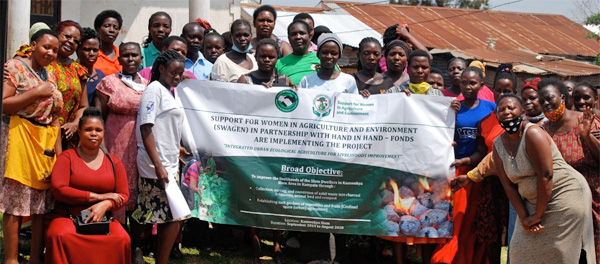
The project employs the strategy of reducing, recycling and re-using solid waste as a tool for adaptation and mitigation of Climate Change by the urban community.
It has the following components:
- Behavioral change
This involves community mobilization, information-education-communication (IEC) of messages for change of attitude towards solid waste. It is aimed at converting people’s traditional regard of waste as despicable to regarding solid waste as a resource. The message content is mainly reduction, reuse and recycling and safe solid waste disposal for maintenance of local infrastructure. It also involves equipping the community with awareness and skills to respond to the adverse effects of Climate Change. It is achieved through use of the electronic (Radio) media, posters, workshops, etc.
- Establishment of court-yard gardens
The biodegradable is separated into material for composting, material for making charcoal briquettes and material for making animal feed. The compost will be used by the project beneficiaries and urban slum households to practice confined space (urban) agriculture. It will be packed in sacks and food crops such as vegetables like lettuce, and fruits like strawberries will be grown on the sacks. The animal feeds will be sold to livestock farmers within and out of Kampala. It provides an alternative especially as the maize crop failure rate has continued to increase owing to Climate Change. The un-biodegradable consists of polythene bags, glass, metal, plastics which will be taken to recycling factories; paper, wood shavings and charcoal dust will be converted into charcoal briquettes and sold at a cheap price to the slum community for cooking. An average household of 6 members uses one 100kg bag of charcoal per week, estimated to be made out of 3 trees, each measuring 3m x 1m. The 100kg bag of charcoal has debris of 5kg charcoal dust as waste. That converts to 12 trees per month per household, 144 trees per year per household.
- Climate proofing infrastructure
Under this component, there is keeping drainage channels clear by collection of solid waste into a central location. It involves sorting of waste into biodegradable and un-biodegradable for reuse, recycling or safe disposal. It is geared at reducing flooding and protection of facilities such as housing and pit latrines against the ravages of flooding due to Climate Change.
- Sustainable Business Development
The women beneficiaries will be organized into cooperatives to generate income from their surplus urban agricultural produce and sale of charcoal briquettes, using the solid waste as a resource.
Main activities:
- Mobilization and sensitization of the community through workshop, radio talk shows, message posters.
- Collection, sorting, and conversion of solid waste into charcoal briquettes, animal feed and compost
- Establishing sack gardens of vegetables and fruits [Confined space (urban) agriculture

